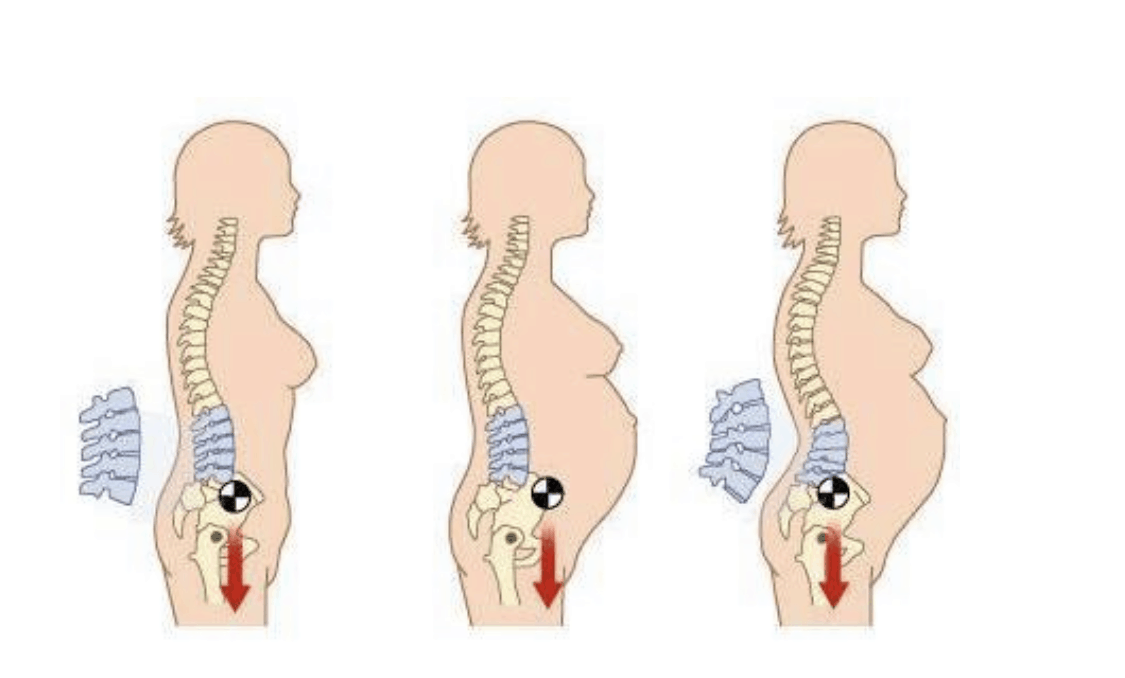Pregnancy Related Back Pain & Posture

Back pain during pregnancy is quite common. In one recent study from 2018, pelvic girdle pain or low back pain was reported during pregnancy in 70 to 86% of women in the U.S. and Europe. Women who experience back pain in pregnancy have a greater risk for back pain postpartum, when left untreated it can become chronic.
Postural changes in pregnancy occur to accommodate for the weight of the growing baby, causing the low back to sway and abdominal muscles to become weak and stretch out. Shoulders will also round forward in response to growing breast tissue, causing the position of the head to drop and the mid back to hunch. Hormonal changes cause joints and ligaments to become lax, resulting in a loss of stability at the spine and pelvis. All of these factors shift a pregnant person’s center of gravity forward, which can further contribute to changes in spinal curvatures and posture.
This file is licensed under the Creative Commons Attribution-Share Alike 3.0 Unported license.
Pregnancy Posture Tips
Using correct posture can help prevent or ease pregnancy related back pain.
Supportive Shoes
Opt for a shoe with a low heel and good arch support, for extra support with standing and walking postures.
Sitting Ergonomics
Choose a chair with low back support. Try rolling up a towel and place it behind your back when sitting at your desk or in a car. Keep keyboards or workstations at proper height to avoid shoulders elevating and rounding forward.
Change Positions
Try to vary positions often. Avoid prolonged standing or take seated rests breaks. When sitting for long periods, try getting up every half hour to improve circulation and to reduce postural strain.
Standing
Avoid sway back posture. Try keeping the pelvis neutral or slightly tucked instead. If standing for long periods, try placing a foot on a small step stool to reduce loading in the spine.
Regular Exercise
Maintaining an exercise routine can be helpful to manage or reduce back pain. Practice regular stretch breaks throughout the day that focus on gentle spinal mobility, like pelvic tilting. Incorporate deep core stability exercises, like sitting on a stability ball, to build strength and endurance in postural muscles.
Practicing good posture while pregnant can help avoid aches and pains and maximize movement and energy. Back pain in pregnancy is common but can be disruptive to daily life, by causing sleep disturbances, difficulty performing household tasks, and have negative emotional effects by increasing fear. The American College of Obstetricians and Gynecologists recommends contacting a provider if back pain is severe or if it lasts more than two weeks.
We Can Help!
Body Harmony Physical Therapy offers one-on-one treatment sessions and provides individualized treatment programs for each patient.
This blog was created for informational purposes only and is not intended to be a substitute for professional medical advice, diagnosis, or treatment. Always seek the advice of your physician or other qualified health provider with any questions you may have regarding a health condition or before beginning a new exercise routine.
Written By: Victoria Garrett, PT, DPT
References:
- Annelie Gutke, Jill Boissonnault, Gill Brook, and Britt Stuge. Journal of Women’s Health.Apr 2018.510-517. http://doi.org/10.1089/jwh.2017.6342
2. https://www.acog.org/womens-health/faqs/back-pain-during-pregnancy







